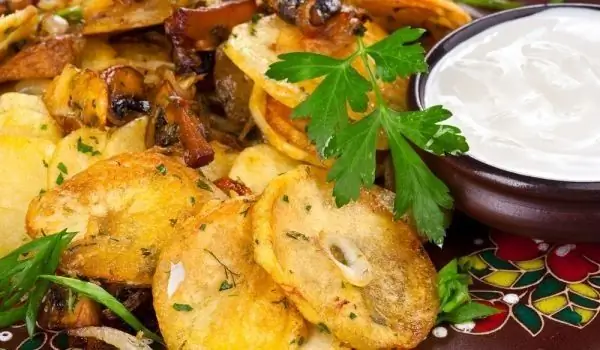2025 Author: Jasmine Walkman | [email protected]. Last modified: 2025-01-23 10:18
Samardala (Nectaroscordum siculum ssp. Bulgaricum syn. Allium bulgaricum) is one of the main ingredients of the traditional in our country colored salt. Samardala is a herbaceous plant that belongs to the Onion family and is endemic to the Balkan Peninsula. As a component of the colored salt and entirely as a spice, the samardala is used dried and crushed.
Translated from Greek Nectaroscordum siculum means nectar garlic and it is no coincidence that the English name of the spice is Honey Garlic (honey garlic). Samardala is also called wild onion, Bulgarian onion, Bulgarian garlic and others. In fact, samardala is a spice that is used to the greatest extent only in Bulgaria and especially in the region of Strandzha, Sliven, Stara Zagora, Kazanlak and Sunny Beach.
In this southeastern part of the country samardala you can find it completely fresh or dried in the markets, and people grow it as a mandatory plant in their backyards. Samardala is also found in smaller quantities in Romania, Moldova, the Crimean peninsula, the Caucasus, even in Turkey and the southern parts of Italy and France.
You can see it growing wild in the undergrowth of beech and hornbeam forests. It is a bulbous plant, from which emerge several thin and up to 40 cm long stalks. Samardala is a close relative of garlic and onion, but its leaves have a different three-rayed shape. One legend says that when God created the plants, he grabbed the leaves of the samardala with 3 fingers to pull it out of the ground and thus the specific shape of the leaves was obtained.

The leaves of samardala spend in March, but its beautiful flowers bloom in April-May. The flowers of the plant are bell-shaped, variegated in a mixture of purple, yellow, pale pink, white, brown. This is the reason why samardala is grown as an ornamental plant by many lovers of flora.
Samardal processing
Samardala has a strong slightly spicy and bitter taste, especially if fresh. Fresh leaves are significantly hotter than onions, garlic, yeast. The most popular, however, is the dried version, in which the leaves are dried for 1 day and ground to a pulp, then mixed with salt.
This mixture was spread and allowed to dry again. Some people crush or grind fresh samardala with salt, which is the more extreme option for its preparation - the spiciness that the plant releases is many times stronger than when cutting onions and your crying is sure. The finished spice is a characteristic green color and in order not to darken, it should be stored in a dry and dark place.

Samardala contains few aromatic substances, so it can not be extracted essential oil. On the other hand, its combination with salt fixes its aromatic substances and that is why the plant is offered dried in this duet. The amount of samardala salt should be 1-1.
Drying itself takes about 30-40 days, in shady, ventilated rooms at a temperature of up to 30 degrees, and the mixture is stirred periodically. If the samardala is dried at a higher temperature, it is possible that its fresh green color will be lost and the spice will turn brown.
Culinary use of samardala
If you decide to try what the dish cooked with samardala, then know that fresh leaves are better not to undergo culinary processing. Use only the dried mixture for this purpose. You can use fresh samardala in salads, especially those with tomatoes and cucumbers, with which the spice goes quite well.

Sprinkle the salad with grated cheese, because samardala successfully complements its taste. With no less success, samardala gives an interesting taste to lettuce or dishes of spinach, dock, nettle.
Dried samardala is excellent for flavoring potatoes cooked in any form, as well as eggs, chicken, lamb and lamb trifles, roasted mushrooms and rice. A toasted slice smeared with butter and sprinkled with samardala evokes a nostalgic childhood memory. It is important to note that the salt in the aromatic spice is as much as the samardala itself, which means that you should use in moderation or if you add the spice to a dish, do not add a lot of salt separately.
Benefits of samardala
Samardala is included in the list of medicinal plants that fall under the provisions of the Medicinal Plants Act SG No. 91 21.09.2002. There is evidence that the plant has a good effect on hypertension, but with the addition of salt, this can be disputed.
Recommended:
Samardala Cures Psoriasis

Samardala is among the not so well known plants. Not many things are known about it and it is not a very common herb. The taste of samardala is quite strong, and can even be described as spicy and bitter. When fresh, the plant resembles horseradish, but its healing properties do not yield in any way.
The Magic Samardala Lowers The Levels Of Bad Cholesterol

Samardala is a traditional Bulgarian herb that most people know is used to make colorful salt. It plays a major role in the specific aroma of many people's favorite spice. Samardala is most common in the Balkans, although it is known in some countries in Asia.
Which Dishes Can We Taste With Samardala?

Most people liken the samardala to garlic or onions and make no mistake - the plant is a close relative of both garlic and onion, but the leaves in cross section have the shape of a star with three rays. The name of samardala translated from Greek means "

